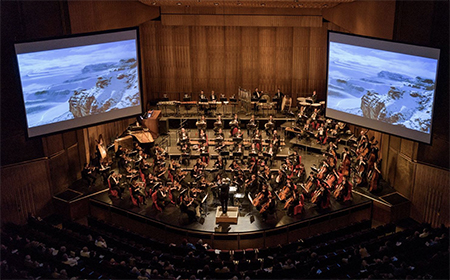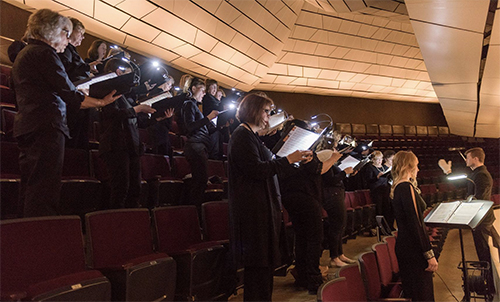by Daniel Hathaway

Musically, the North Pole was represented by Einojuhani Rautavaara’s Cantus arcticus, the South Pole by Ralph Vaughan Williams’ Sinfonia antartica. Mendelssohn’s The Hebrides captures the relentless motion of the waves in Fingal’s Cave, and Ottorino Respighi’s The Pines of Rome takes snapshots of the Eternal City’s famous trees from four angles.
Wilkins was both conductor and docent, leading the audience on a guided tour of the four works with verbal program notes and projections, but happily for those of us who have trouble paying equal attention to visuals and music, he let the music speak for itself during the performance of the first three works.
The ASO allowed Mendelssohn’s evocative music to flow and ebb realistically in The Hebrides, making smooth transitions into the overture’s scherzo-like moments.

Moving on to warmer climes, Wilkins and the Akron Symphony gave vivid readings of the four movements of Respighi’s The Pines of Rome, in which the composer said he “uses nature as a point of departure, in order to recall memories and visions.” Those include children at play under the canopy of the grove of the Villa Borghese, funereal chants issuing from the entrance to a catacomb, moonlight over the Janiculum — with a recorded nightingale for extra effect — and the conjuring of ancient Roman legions marching to the Capitoline Hill via the Appian Way.

After intermission, Wilkins and the Orchestra took the audience as far south as possible with music Vaughan Williams originally wrote for the 1948 feature film Scott of the Antarctic, chronicling Robert Falcon Scott’s disastrous expedition to the South Pole in 1911.

Well-played as Vaughan Williams’ Seventh Symphony was, the experience of hearing forty-some minutes of panoramic music cued to shifting images of snow and ice added up to a magnificent monotony, even with the visual antics of penguins for comic relief. Or was it just a case of late winter fatigue at the end of March?
Photos by Dale Dong.
Published on ClevelandClassical.com March 27, 2018.
Click here for a printable copy of this article



